Not known Facts About Wedge Barriers
Indicators on Wedge Barriers You Should Know
Table of ContentsWhat Does Wedge Barriers Mean?Wedge Barriers for Dummies

14 and the surface area 12 to which the obstacle 10 is safeguarded may be made from concrete - Wedge Barriers. 2, the barrier 10 is installed to or includes a support or subframe (e. g., support 30 shown in FIG. 2 )protected under the surface area 12. For instance, the bather 10 might be bolted to the support or protected to the anchor by various other mechanical fasteners. In the detailed personification, the barrier 10 includes a wedge plate 16, which consists of a section that is considerably parallel with the surface area 12 when the obstacle 10 is in the withdrawed placement. Simply put, automobiles or people may pass over the obstacle 10 when the barrier 10 remains in the pulled back setting and experience minor altitude about the surface area 12 while on the barrier 10. As gone over thoroughly listed below, when the obstacle 10 is in the deployed setting, the wedge plate 16 is held and sustained in an elevated setting by a lifting device of the barrier 10. Additionally, the parts 18 may be bolted or otherwise mechanically paired to each other. In this fashion, repair work or substitute of one or even more elements 18 might be simplified and structured. That is, repair work or replacement of single parts
18 may be done faster, quickly, and price effectively. FIG. In particular embodiments, the support 30 might be a steel structure including plates, light beams(e. g., I-beams ), and/or other frameworks that are safeguarded within the foundation 14, which might be concrete. At the surface more tips here area 12, a top side find more information 28 of the anchor 30 might go to least partially revealed
, consequently allowing the add-on of the obstacle 10 to the support 30. g., threaded holes)in one or more beam of lights or plates of the support 30 may be subjected to the surface 12. In this manner, screws 32 or various other mechanical fasteners may be utilized to secure the barrier 10 to the support 30. As the barrier 10 is placed to the surface 12 of the foundation 14, collection of debris and various other product beneath the barrier may be minimized, and parts of the bather 10 may not be exposed to below grade atmospheres. As shown by referral numeral 52, the training device 50 consists of elements got rid of beneath the wedge plate 16. The parts 52 beneath the wedge plate 16 might consist of an electromechanical actuator, a webcam, one or more cam surfaces, and so forth. Furthermore, the lifting mechanism 50 consists of a springtime setting up 54
The springtime pole try this site 58 is paired to a webcam(e. g., cam 80 received FIG. 4) of the lifting system 50. The springs 60 disposed about the springtime rod 58 are held in compression by spring sustains 62, consisting of a fixed springtime assistance 64. That is, the set spring support 64 is taken care of loved one to the structure 14 et cetera of the bather 10.
What Does Wedge Barriers Do?
g., spring assistance 65 )may be dealt with to the end of the springtime rod 58 to make it possible for compression of the springs 60. As the springs 60 are pressed between the springtime sustains 62, the springtime setting up 54 creates a force acting upon the cam coupled to the springtime rod 58 in an instructions 66. For example, the remaining force put on
the camera to deploy the wedge plate 16 might be provided by an electromechanical actuator 84 or various other actuator. The springtime assembly 54 and the actuator 84(e. g., electromechanical actuator)might operate with each other to convert the cam and raise the wedge plate 16.
As discussed above, in the deployed placement, the wedge plate 16 offers to obstruct gain access to or traveling beyond the obstacle 10. The barrier 10(e. g., the wedge plate 16 )may block pedestrians or automobiles from accessing a residential or commercial property or pathway. If a car is taking a trip towards the deployed wedge plate 16(e. For example, in one situation, the safety and security legs 86 might be expanded duringmaintenance of the barrier 10.